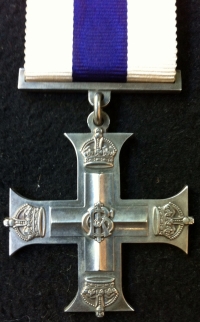
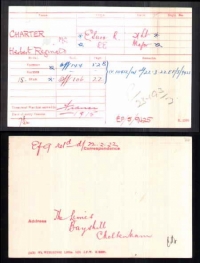






 Military Cross, (Privately Engraved: "Major H.R. Charter 1917") 1914-15 Star (2/Lieut. East Surrey Regt) British War & Victory Medals with M.I.D. (Major) Defence Medal.
Military Cross, (Privately Engraved: "Major H.R. Charter 1917") 1914-15 Star (2/Lieut. East Surrey Regt) British War & Victory Medals with M.I.D. (Major) Defence Medal.
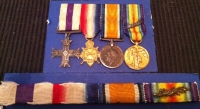 With relating ribbon bar and miniatures & full details with copy obituary.
Herbert Reginald Charter M.C. (London Gazette 4/6/17 - Temp/Lieut.)
"For services with the Special Gas Brigade R.E." (for which he was also mentioned in despatches) M.I.C. confirms Trio as 2./Lieut. East Surrey Regt. & Major R.E.
Medals issued 1922, to "The Limes", Bayshill, Cheltenham.
With copies of medal rolls.
[BIOGRAPHY]
He was born on 5th November 1890 in East Dulwich, London S.E. and lived at 3 Keston Road where his father is described as an "agent".
Eucated at Bellenden Road School (London County Council) and at Wilson's Grammar School in Camberwell before studying Natural Sciences at Emmanuel College Cambridge 1909-12 (M.A.) where he was an outstanding scholar.
He was then appointed in1913 as a lecturer at The Wye Agricultural College, Kent, until entering military service in The Great War from 1914-1919.
He initially served in the trenches with the 7th Bn. East Surrey Regiment before his qualifications saw him transferred to the Special Gas Brigade R.E.
He served as Gas Officer of the 12th Division in France (Military Cross & Mentioned in Dispatches) before being posted to Mesopotamia as Gas and Chemical Adviser to:
With relating ribbon bar and miniatures & full details with copy obituary.
Herbert Reginald Charter M.C. (London Gazette 4/6/17 - Temp/Lieut.)
"For services with the Special Gas Brigade R.E." (for which he was also mentioned in despatches) M.I.C. confirms Trio as 2./Lieut. East Surrey Regt. & Major R.E.
Medals issued 1922, to "The Limes", Bayshill, Cheltenham.
With copies of medal rolls.
[BIOGRAPHY]
He was born on 5th November 1890 in East Dulwich, London S.E. and lived at 3 Keston Road where his father is described as an "agent".
Eucated at Bellenden Road School (London County Council) and at Wilson's Grammar School in Camberwell before studying Natural Sciences at Emmanuel College Cambridge 1909-12 (M.A.) where he was an outstanding scholar.
He was then appointed in1913 as a lecturer at The Wye Agricultural College, Kent, until entering military service in The Great War from 1914-1919.
He initially served in the trenches with the 7th Bn. East Surrey Regiment before his qualifications saw him transferred to the Special Gas Brigade R.E.
He served as Gas Officer of the 12th Division in France (Military Cross & Mentioned in Dispatches) before being posted to Mesopotamia as Gas and Chemical Adviser to: 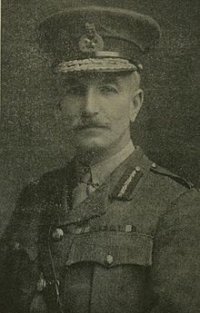 Commander-in-Chief, Lieutenant General Sir William Raine Marshall, GCMG, KCB, KCSI.
Following the Great War he became Chemistry Master at Cheltenham College 1919-1929 and later served as Warden and Tutor at the College of Apprentices at Leyland Motors in Lancashire 1930-40. He was Chemistry Master at Merchiston Castle School in Edinburgh 1941-1954 and Housemaster of Rogerson East 1943-1946.
He retired in 1954 and died on 12th September 1965. His obituary noted that he was an outstanding scholar having had a small book on scientific measurement published in the 1920s. When he first came to Merchiston he was very ill and was not expected to survive, but he recovered.
He was a noted bridge and chess player, a cricket coach and pianist, and claimed to be the first student to play real jazz at Cambridge.
He served during W.W.2 as a fire watcher in Edinburgh which gave him qualification for the defence medal.
[GAS GAS GAS !!!]
The Battle of Bellewaarde (24–25 May 1915)
During World War I, the Second Battle of Ypres was fought from 22 April – 25 May 1915 for control of the strategic Flemish town of Ypres in western Belgium. On 24 May the Germans released a gas attack on a 4.3 mile front near Hooge (50.847°N 2.950°E). Although British troops defended and repulsed the initial German attack, there were heavy losses on account of the gas and they were eventually forced to retreat north and south. Failed British counterattacks then forced a British retreat of just over half a mile northwards. At the end of the battle, the Ypres salient was compressed into an area 5 miles long & 3 miles deep with Ypres closer to the line. The city, bombarded by artillery fire, was demolished. This was the final German attack launched as the Battle of Bellewaarde Ridge and ended the Second Battle of Ypres.
Although poison gas had been previously used on the Eastern Front, it's use on the Western front totally surprised the Allies and about 7,000 gas casualties were transported to field ambulances units and treated in casualty clearing stations. In May and June, 350 British deaths were recorded from gas poisoning. Both sides further developed gas weapons and counter-measures, which changed the nature of gas warfare with both the French and British using gas at the Battle of Loos in late September. Gas protection was somewhat improved with the issue of improvised respirators made from cotton waste pads impregnated with sodium hypo-sulphite, sodium bicarbonate and glycerin. The respirators made little difference, however, due to lack of training and the use of local contraptions and poorly-made items imported from Britain.
Commander-in-Chief, Lieutenant General Sir William Raine Marshall, GCMG, KCB, KCSI.
Following the Great War he became Chemistry Master at Cheltenham College 1919-1929 and later served as Warden and Tutor at the College of Apprentices at Leyland Motors in Lancashire 1930-40. He was Chemistry Master at Merchiston Castle School in Edinburgh 1941-1954 and Housemaster of Rogerson East 1943-1946.
He retired in 1954 and died on 12th September 1965. His obituary noted that he was an outstanding scholar having had a small book on scientific measurement published in the 1920s. When he first came to Merchiston he was very ill and was not expected to survive, but he recovered.
He was a noted bridge and chess player, a cricket coach and pianist, and claimed to be the first student to play real jazz at Cambridge.
He served during W.W.2 as a fire watcher in Edinburgh which gave him qualification for the defence medal.
[GAS GAS GAS !!!]
The Battle of Bellewaarde (24–25 May 1915)
During World War I, the Second Battle of Ypres was fought from 22 April – 25 May 1915 for control of the strategic Flemish town of Ypres in western Belgium. On 24 May the Germans released a gas attack on a 4.3 mile front near Hooge (50.847°N 2.950°E). Although British troops defended and repulsed the initial German attack, there were heavy losses on account of the gas and they were eventually forced to retreat north and south. Failed British counterattacks then forced a British retreat of just over half a mile northwards. At the end of the battle, the Ypres salient was compressed into an area 5 miles long & 3 miles deep with Ypres closer to the line. The city, bombarded by artillery fire, was demolished. This was the final German attack launched as the Battle of Bellewaarde Ridge and ended the Second Battle of Ypres.
Although poison gas had been previously used on the Eastern Front, it's use on the Western front totally surprised the Allies and about 7,000 gas casualties were transported to field ambulances units and treated in casualty clearing stations. In May and June, 350 British deaths were recorded from gas poisoning. Both sides further developed gas weapons and counter-measures, which changed the nature of gas warfare with both the French and British using gas at the Battle of Loos in late September. Gas protection was somewhat improved with the issue of improvised respirators made from cotton waste pads impregnated with sodium hypo-sulphite, sodium bicarbonate and glycerin. The respirators made little difference, however, due to lack of training and the use of local contraptions and poorly-made items imported from Britain. 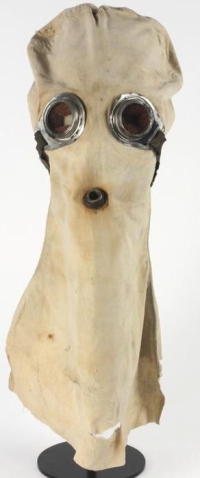 The "P helmet" (or "Tube Helmet") soaked in sodium phenate was issued by December 1915, and the PH helmet (effective against phosgene) was issued in early 1916.
The "P helmet" (or "Tube Helmet") soaked in sodium phenate was issued by December 1915, and the PH helmet (effective against phosgene) was issued in early 1916.

 AN EXCELLENT M.C. / M.I.D. GROUP WITH MINIATURES (& THE THREE DIFFERENT SIZES OF M.I.D. EMBLEMS) TO ONE OF THE PIONEERS OF BRITISH CHEMICAL WARFARE. WITH A FILE OF PAPERS & RESEARCH.£1950 with part exchanges welcome.
AN EXCELLENT M.C. / M.I.D. GROUP WITH MINIATURES (& THE THREE DIFFERENT SIZES OF M.I.D. EMBLEMS) TO ONE OF THE PIONEERS OF BRITISH CHEMICAL WARFARE. WITH A FILE OF PAPERS & RESEARCH.£1950 with part exchanges welcome.